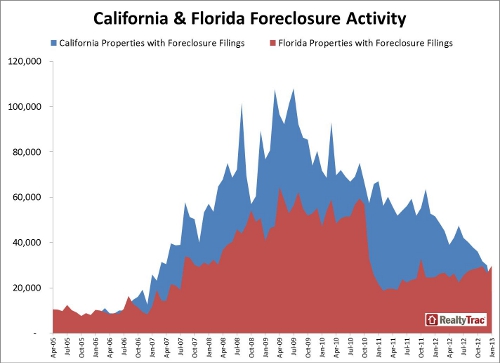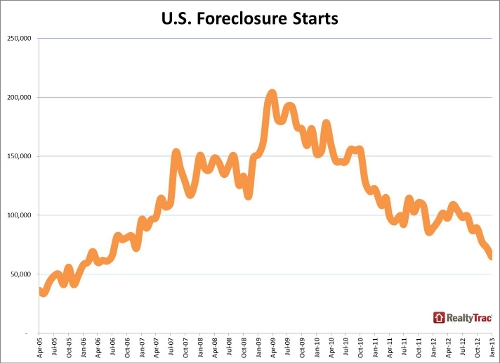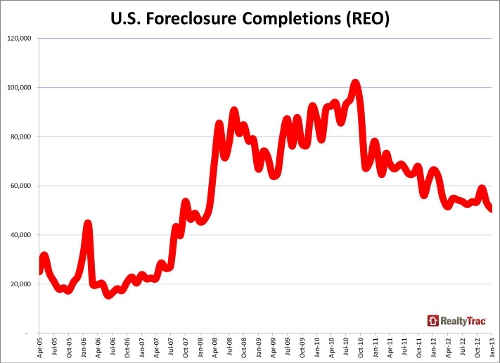You are viewing our site as a Broker, Switch Your View:
Agent | Broker Reset Filters to Default Back to ListU.S. Foreclosure Starts Fall to Six-Year Low in January
March 05 2013
IRVINE, Calif. — RealtyTrac® (www.realtytrac.com), the leading online marketplace for foreclosure properties and real estate data, today released its U.S. Foreclosure Market Report™ for January 2013, which shows foreclosure filings — default notices, scheduled auctions and bank repossessions — were reported on 150,864 U.S. properties in January, a decrease of 7 percent from the previous month and down 28 percent from January 2012. The report also shows one in every 869 U.S. housing units with a foreclosure filing during the month
 "The U.S. foreclosure landscape in January was profoundly altered by the effects of new legislation that took effect in California on the first of the year," said Daren Blomquist, vice president at RealtyTrac. "Dubbed the Homeowners Bill of Rights, this legislation extends many of the principles in the national mortgage settlement — including a prohibition on so-called dual tracking and requiring a single point of contact for borrowers facing foreclosure — to all mortgage servicers operating in California. In addition the new law imposes fines of up to $7,500 per loan for filing of multiple unverified foreclosure documents. As a result, the downward foreclosure trend in California accelerated into hyper speed in January, decisively shifting the balance of power when it comes to the nation's foreclosure activity.
"The U.S. foreclosure landscape in January was profoundly altered by the effects of new legislation that took effect in California on the first of the year," said Daren Blomquist, vice president at RealtyTrac. "Dubbed the Homeowners Bill of Rights, this legislation extends many of the principles in the national mortgage settlement — including a prohibition on so-called dual tracking and requiring a single point of contact for borrowers facing foreclosure — to all mortgage servicers operating in California. In addition the new law imposes fines of up to $7,500 per loan for filing of multiple unverified foreclosure documents. As a result, the downward foreclosure trend in California accelerated into hyper speed in January, decisively shifting the balance of power when it comes to the nation's foreclosure activity.
"For the first time since January 2007 California did not have the most properties with foreclosure filings of any state. Instead that dubious distinction went to Florida, where January foreclosure activity increased on an annual basis for the 11th time in the last 13 months."
High-level findings from the report:
 U.S. foreclosure starts were down 11 percent from the previous month and down 28 percent from a year ago to the lowest level since June 2006 — a 79-month low.
U.S. foreclosure starts were down 11 percent from the previous month and down 28 percent from a year ago to the lowest level since June 2006 — a 79-month low.
U.S. bank repossessions (REO) decreased 5 percent from the previous month and were down 24 percent from January 2012 to the lowest level since February 2008.
The national decrease in foreclosure starts was caused in large part by a sharp drop in California notices of default (NOD) in January, down 62 percent from December and down 75 percent from January 2012 to the lowest level since October 2005.
Scheduled foreclosure auctions increased from the previous month in 26 states and the District of Columbia, hitting 12-month or more highs in several key judicial foreclosure states, including Florida, Illinois, Pennsylvania, and New Jersey, although foreclosure starts were down on a year-over-year basis in Florida, Illinois and Pennsylvania.
 Some of the biggest year-over-year increases in foreclosure starts came in non-judicial foreclosure states where legislation or court rulings stalled foreclosure actions last year: Arkansas (539 percent increase), Washington (179 percent increase), and Nevada (87 percent increase).
Some of the biggest year-over-year increases in foreclosure starts came in non-judicial foreclosure states where legislation or court rulings stalled foreclosure actions last year: Arkansas (539 percent increase), Washington (179 percent increase), and Nevada (87 percent increase).
Florida posted the nation's highest state foreclosure rate for the fifth month in a row in January, and also had the highest number of properties with foreclosure filings for the month, marking the first month since January 2007 that California has not had the highest number of properties with foreclosure filings.
Florida, Nevada, Illinois post highest state foreclosure rates
The Florida foreclosure rate ranked highest among the states for the fifth month in a row. One in every 300 Florida housing units had a foreclosure filing in January — more than twice the national average. A total of 29,800 Florida properties had a foreclosure filing during the month, up 12 percent from the previous month and up 20 percent from January 2012.
With one in every 344 housing units with a foreclosure filing in January, Nevada posted the nation's second highest foreclosure rate for the fourth consecutive month. Overall Nevada foreclosure activity decreased 43 percent from a year ago, but foreclosure starts (NODs) increased 19 percent from the previous month and were up 87 percent from January 2012 to a 16-month high.
A 32 percent month-over-month jump in scheduled foreclosure auctions helped the Illinois foreclosure rate rise to third highest among the states in January. One in every 375 Illinois housing units had a foreclosure filing during the month.
Other states with foreclosure rates among the nation's 10 highest were Arizona (one in 501 housing units with a foreclosure filing), Georgia (one in 513 housing units), Ohio (one in 612 housing units), Washington (one in 674 housing units), California (one in 753 housing units), Indiana (one in 784 housing units), and Michigan (one in every 837 housing units).
Florida cities account for six of top 10 metro foreclosure rates
With one in every 223 housing units with a foreclosure filing in January, the Ocala, Fla., metro area posted the nation's highest foreclosure rate in January among metropolitan statistical areas with a population of 200,000 or more.
Five other Florida metro areas documented foreclosure rates in the top 10: Miami at No. 2 (one in 228 housing units with a foreclosure filing); Orlando at No. 3 (one in 241 housing units); Jacksonville at No. 8 (one in 301 housing units); Tampa at No. 9 (one in 307 housing units); and Lakeland at No. 10 (one in 332 housing units).
Other cities with foreclosure rates in the top 10 were Rockford, Ill., at No. 4 (one in every 265 housing units with a foreclosure filing); Stockton, Calif., at No. 5 (one in every 277 housing units); Las Vegas at No. 6 (one in 283 housing units); and Chicago at No. 7 (one in 293 housing units).
About RealtyTrac Inc.
RealtyTrac (www.realtytrac.com) is the leading supplier of U.S. real estate data, with more than 1.5 million active default, foreclosure auction and bank-owned properties, and more than 1 million active for-sale listings on its website, which also provides essential housing information for more than 100 million homes nationwide. This information includes property characteristics, tax assessor records, bankruptcy status and sales history, along with 20 categories of key housing-related facts provided by RealtyTrac's wholly-owned subsidiary, Homefacts®. RealtyTrac's foreclosure reports and other housing data are relied on by the Federal Reserve, U.S. Treasury Department, HUD, numerous state housing and banking departments, investment funds as well as millions of real estate professionals and consumers, to help evaluate housing trends and make informed decisions about real estate.
To view the original post, visit RealtyTrac.









